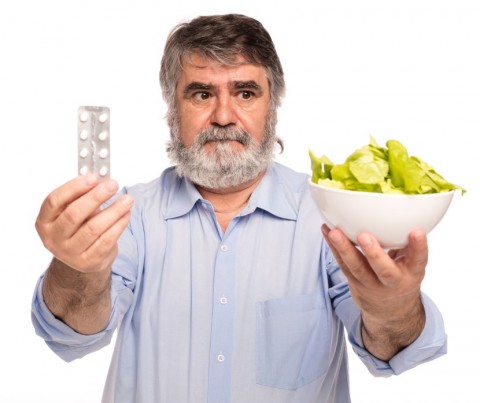DrCarney.com Blog
Vegetable Consumption Being Sidelined
Let's talk about trends. If you're a banana, a carrot, or a head of lettuce, the future isn't looking too bright for you right now. The Produce for Better Health Foundation (PBHF) commissioned a study and found that fruit and vegetable consumption has been trending down. According to the report, if the 50+ crowd doesn't wake up and smell the lifestyle diseases headed their way, then there is little hope for an uptick in produce consumption in the near future.
In their "State of the Plate: 2015 Study on America's Consumption of Fruit and Vegetables," the PBHF reports that over the past five years per capita fruit and vegetable consumption has declined seven percent. Vegetable consumption is down seven percent, and fruit consumption has dropped two percent since 2009. Who is driving the trend? Older eaters.
Americans Sidelining the Veggie Sides
With the unexpected exception of teens and men ages 18 - 34, vegetable consumption is down pretty much across the board. But younger consumers (children and adults 18-44) are actually eating more fruit than their counterparts five years ago. Unfortunately, their increase isn't enough to counteract the overall downward trend which has been driven by those over 44 years old. Traditionally older diners have been reliable produce consumers, but apparently times have changed. According to the study, "The overall losses seen in fruit and vegetable consumption have been driven by double digit declines among adults ages 45 and older, and particularly those ages 65 and older, who are the highest fruit and vegetable consumers." As a group, people 45+ are eating less fruit at all meals, less fruit "as is," and less fruit for dessert. And generally everyone is eating fewer veggies.
The study attributes the decline in vegetable consumption to Americans' increasing demand for simplified meals. Vegetables are typically side dish fare, and the trend toward one-dish dinners, limited-ingredient recipes, and ready-to-eat or frozen main dishes has pushed veggies off the lunch and supper plates. It used to be that lunch and supper featured "protein" (read: an animal product such as beef, chicken, or fish) at the center of the plate, so vegetables were a natural pairing. Now, however, pizza or a sandwich are more likely to take center stage and vegetables just don't make it onto the menu. Even dessert, where fruit used to flourish, is being ditched in the name of simplicity.
Wilting Hopes for the Future of Produce Consumption
Projecting fruit and vegetable consumption over the next five year period, the authors of the PBHF study expect a four percent increase in total fruit and total vegetable consumption. While any increase at all sounds welcome, the unfortunate fact is that this projected increase is only due to population growth. Per capita consumption is expected to stay relatively flat. The only real variable in the projection lies in the hands (and forks) of Americans over 44. The study authors are optimistic that older Americans will become concerned about their health and respond by eating more fruit and veggies, pushing up overall produce consumption. But, warn the report's authors, if the 45 and over crowd doesn't change their eating habits, hopes for the future of produce consumption are wilting. The report states:
If current food preparation and consumption behaviors among consumers ages 50+, are not modified or changed, the full growth potential of fruit and vegetables will likely not be realized during the coming years. This is due to the negative generational (cohort) effect for both fruit and vegetables among older consumers, which means that 50+ year olds today are consuming fruit and vegetables less often than their counterparts ten years ago.
The authors of the study indicate that the waning interest in produce among the 50+ group is a little puzzling. "The health benefits of fruit and vegetables should be a sweet spot with this group," say the authors. They speculate that fruits and veggies must not be meeting a "need" of this group, and that "older consumers may have also found ways other than consuming fruit and vegetables to address health." Pills perhaps? In my medical practice, a certain percentage of patients are more open to the idea of taking a prescription medication for life — and facing the possible side effects — than they are to changing their eating habits.
As a physician, this trend of decreased produce consumption is alarming to me. A diet rich in low-fat, whole plant foods is the great hope for America's health. The less we rely on animal products and processed foods, and the more we rely on whole fruits and vegetables free from added oil, the more we reduce our risk of heart disease, stroke, diabetes, obesity, hypertension, and other diseases related to lifestyle. As we age, our diet becomes increasingly important as we try to mitigate the damage done by a lifetime of eating a Western diet that included processed foods and animal products. Of course, the younger we are when we adopt an optimal eating pattern of low-fat, whole plant foods like the Starch-Smart® System, the better health we'll enjoy as we reach middle age. It's never too late, however, to optimize the health we have.
Grandma Never Had it so Good
I encourage all of us to do our part in reversing this trend. Each of us can start a revolution at our own dinner tables by bringing back grandma's custom of serving vegetable side dishes. And it's easier now than ever. Making salad can be as quick as tossing a handful of ready-to-eat lettuce onto our plate with a squeeze of lemon and a sprinkle of herbs or salt. Fun-sized veggies like grape tomatoes, mini sweet peppers, snap peas, and baby carrots are delicious and hassle free. Frozen vegetables with no oily sauces now come in microwave-ready pouches. And fresh veggies and fruit are sold precut and ready for steaming or crunching raw.
When tempted to skip the extra serving of produce in favor of a one-dish meal, consider how much quicker it is to grab a serving of veggies than it is to take extra trips to the doctor's office for preventable diseases. The decision is really that simple. By reversing the trend of low fruit and vegetable consumption, we can reverse the trend of higher and higher rates of cardiovascular disease, high blood pressure, obesity, and diabetes. It happens one bite at a time.
Scroll Down Page to Leave Comments

Organized Resources to Share
Share our favorite whole-food plant-based no-oil Resources with your friends and for real meaningful sharing, invite them to Join Our Community.
Preview the "Cancer Prevention & Women's Health" Trailer
Survive and Thrive: Which common (but seemingly unrelated) factors link many health problems together, including cancer and other women's health issues? Is cancer preventable? This DVD shows you which disease risks are worsened by excess estrogen, which you create in your body by choices in foods and beverages. Banish multiple health problems with the Starch-Smart® System.
When you subscribe to the blog, we will send you an e-mail when there are new updates on the site so you wouldn't miss them.




